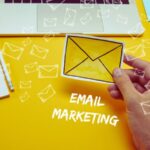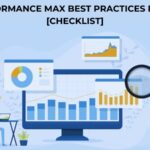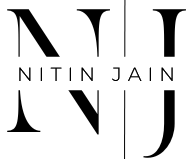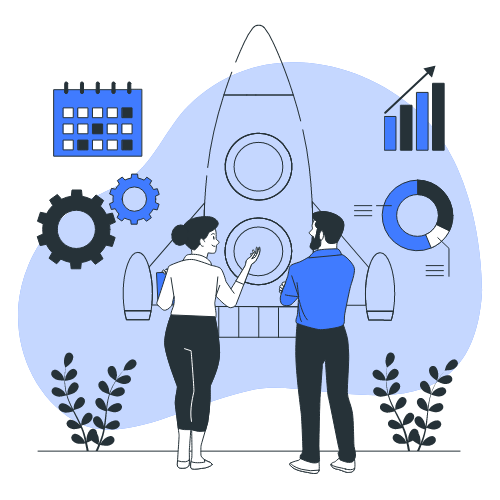Email marketing has evolved drastically over the past decade, and now in 2025, it’s more dynamic, intelligent, and personalized than ever before. With constant shifts in consumer behavior, privacy laws, and technological advancements, digital marketers are required to rethink and refine their email strategies.
Gone are the days when simply blasting a monthly newsletter could yield results. Today’s audiences demand hyper-relevance, real-time personalization, and seamless user experiences across devices and channels. If you want to stay ahead of your competition and win customer loyalty, you must stay on top of the latest trends.
So let’s dive deep into the top email marketing strategies to embrace in 2025 that will help you craft impactful campaigns, boost open rates, and deliver real ROI.
Top 10 Email Marketing Strategies to Use in 2025
1. Email Marketing Strategies 2025
To thrive in the inbox in 2025, email marketing must be a harmonious blend of data-driven tactics, automation, and user-centric content. Marketers are now combining psychology, AI, and analytics to deliver messages that don’t just sell, but resonate. The following strategies are rooted in these principles and tested by top brands across industries.
From personalization to predictive analytics, the rules of engagement have transformed. These are no longer “nice-to-have” strategies—they’re essential pillars for a high-converting email program.
2. AI-Powered Personalization Techniques
Artificial Intelligence has redefined how we approach personalization. In 2025, AI tools don’t just help segment lists—they dynamically alter subject lines, visuals, product recommendations, and CTAs based on user behavior, preferences, and real-time activity.
Emails today are crafted to adapt content blocks based on the recipient’s last website visit, favorite product categories, or even weather conditions in their location. This level of detail builds trust and feels genuinely human. Tools like Klaviyo and ActiveCampaign now offer machine learning features that optimize email content for each subscriber individually.
Hyper-personalization is about more than just customization—it’s about delivering relevant experiences at scale, making each subscriber feel seen and understood.
3. Segmentation Based on Behavioral Triggers
If you’re still segmenting only by age or gender, you’re missing the point. Behavioral segmentation means dividing your audience based on how they interact with your brand—like abandoned carts, past purchases, content views, and email clicks.
Trigger-based segmentation allows you to automate incredibly relevant emails at just the right moment. For instance, someone who views a product but doesn’t purchase can automatically receive a product demo email or a limited-time offer.
This smart segmentation leads to significantly higher open and conversion rates because it speaks directly to the user’s current intent and mindset. Marketers who use behavioral triggers report 3x more engagement than generic campaigns.
4. Interactive Email Content Ideas
Static emails are being replaced by interactive, engaging experiences. With AMP for Email and HTML5, emails in 2025 feel like mini-web apps.
Imagine letting users rate products, complete surveys, spin a wheel for a discount, or browse a carousel—all within the email itself. This not only reduces the steps to conversion but also increases the time users spend engaging with your content.
When done correctly, interactive emails also reduce bounce rates and improve deliverability. Email becomes not just a communication tool—but an immersive experience.
5. Mobile-First Email Design
More than 70% of users now check their emails on mobile devices. If your emails aren’t optimized for mobile in 2025, you’re essentially leaving money on the table.
But it’s no longer about just being “responsive.” Mobile-first design prioritizes the mobile experience over desktop. This means simplified navigation, tappable CTAs, large fonts, and mobile-friendly layouts with fewer columns.
Shorter subject lines, concise preview text, and clear CTA placement are essential for grabbing the thumb-scrolling audience’s attention. Emails that are easy to read on the go significantly outperform desktop-centric designs.
6. Hyper-Automation in Email Marketing
Hyper-automation goes beyond basic workflows. In 2025, this means integrating AI with customer data platforms (CDPs) to predict user behavior, automate decision-making, and craft entire multi-channel journeys—without manual input.
Think: welcome sequences that adapt based on user actions, or drip campaigns that change tone based on engagement levels. These intelligent automations save time while increasing relevance and impact.
Hyper-automation also connects email with CRM, SMS, social media, and even customer support—creating a seamless ecosystem.
7. User-Generated Content in Emails
Social proof is king, and 2025 is all about authenticity. Showcasing real reviews, user-submitted photos, and customer testimonials directly in your emails builds trust and improves click-through rates.
Brands like Glossier and Airbnb have seen a spike in engagement by embedding UGC galleries into their emails. It’s one thing for a brand to say, “We’re the best,” but entirely another when real users say it.
Including UGC makes your content more relatable, increases brand credibility, and encourages other users to contribute, fueling a cycle of engagement.
8. First-Party Data Collection Techniques
With the death of third-party cookies and stricter privacy laws, 2025 demands ethical, consent-based data strategies.
Email marketing now relies on first-party and zero-party data. This includes data users willingly provide—like preferences, interests, and purchase behavior.
Smart forms, surveys, preference centers, and progressive profiling help gather this goldmine of insights. Not only does this improve personalization, but it also ensures compliance with GDPR, CCPA, and other emerging data laws.
Respecting privacy while offering value in exchange for data is the foundation of sustainable email marketing.
9. Storytelling and Conversational Copywriting
Inboxes are crowded. The brands that stand out are those that tell a story, evoke emotion, and create connections.
2025 is all about human-to-human marketing. Instead of sounding robotic or corporate, successful email copy now feels like a friend reaching out. Whether you’re writing a launch email or a holiday sale, use narrative frameworks, emotion-driven subject lines, and a conversational tone.
Think less “Buy now” and more “Here’s a story about how this product changed someone’s life.” That shift creates relatability and conversions.
10. Smart Send-Time Optimization
Timing can make or break an email campaign. Thankfully, we now have tools that predict when each subscriber is most likely to open and act.
Platforms like Iterable and Mailchimp have introduced AI-based send-time optimization that schedules emails down to the individual level.
So instead of sending a blast at 10 a.m. on Tuesday, your emails are sent at 7:16 a.m. to some and 6:05 p.m. to others—based on real engagement data. It’s subtle, but the results are powerful: higher open rates, better CTRs, and happier subscribers.
Final Thought
Email marketing in 2025 is a blend of art, data, and technology. The key to success lies in being user-centric, ethically data-driven, and creatively consistent.
These strategies aren’t just trends, they’re blueprints for lasting engagement and profitability. Whether you’re a seasoned marketer or just revamping your campaigns, embracing these techniques can transform your email results.
So start today. Review your current strategy, adopt what fits your audience, and prepare to dominate the inbox this year and beyond.
Frequently Asked Questions About Email Marketing Strategies 2025
Q1. What’s the most effective email marketing strategy in 2025?
Answer: AI-driven personalization combined with behavioral segmentation stands out as the most effective approach.
Q2. How important is mobile optimization for emails now?
Answer: Crucial. With the majority of users opening emails on mobile, optimizing for small screens is no longer optional—it’s mandatory.
Q3. Is email still relevant in 2025 with all the new channels?
Answer: Absolutely. Email offers direct access, better ROI, and personalization capabilities unmatched by other platforms.
Q4. How can I improve my email open rates?
Answer: Use personalized subject lines, optimize send-times, and continuously test different formats and content.
Q5.What tools should I use for email marketing in 2025?
Answer: Klaviyo, ActiveCampaign, ConvertKit, HubSpot, and Mailmodo are top contenders for advanced features and integrations.
Author Profile

- Nitin Jain - C.E.O - India PR Distribution
- Nitin Jain is the founder and C.E.O of India PR Distribution - India's top Press Release Distribution and PR Agency. Nitin has more than 20 years of experience in PR, Corporate Communications, Digital Marketing, Branding Strategy and Lead generation.
Latest entries
 Email MarketingMay 7, 202510 Best Email Marketing Strategies to Use in 2025
Email MarketingMay 7, 202510 Best Email Marketing Strategies to Use in 2025 Digital MarketingApril 15, 202510 Best Practices for Optimizing Google Performance Max Campaigns
Digital MarketingApril 15, 202510 Best Practices for Optimizing Google Performance Max Campaigns Content WritingMarch 12, 2025The Ultimate Guide to AI Content Creation: Boost Your Business with Smart AI Strategies
Content WritingMarch 12, 2025The Ultimate Guide to AI Content Creation: Boost Your Business with Smart AI Strategies Digital MarketingFebruary 14, 202510 Performance Max Best Practices Exposed [CHECKLIST]
Digital MarketingFebruary 14, 202510 Performance Max Best Practices Exposed [CHECKLIST]

